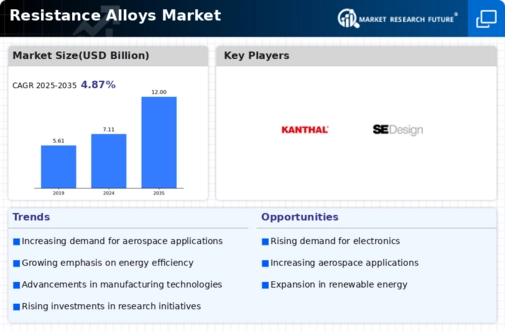Market Growth Projections
The Global Resistance Alloys Market Industry is projected to experience substantial growth in the coming years. With a market size of 7.11 USD Billion anticipated in 2024, the industry is expected to expand significantly, reaching an estimated 12.0 USD Billion by 2035. This growth trajectory indicates a compound annual growth rate (CAGR) of 4.87% from 2025 to 2035. Such projections reflect the increasing demand for resistance alloys across various sectors, driven by technological advancements, industrialization, and the need for high-performance materials. The market's expansion is indicative of the critical role that resistance alloys play in modern manufacturing and engineering applications.
Growing Renewable Energy Sector
The expansion of the renewable energy sector is a key driver for the Global Resistance Alloys Market Industry. As the world shifts towards sustainable energy sources, materials that can withstand high temperatures and corrosive environments are increasingly required. For instance, resistance alloys are utilized in solar thermal power plants and wind turbine components, where durability and efficiency are paramount. This growing demand aligns with global efforts to reduce carbon emissions and transition to cleaner energy sources. Consequently, the market is expected to see substantial growth, with the potential for increased investment in research and development to create more efficient resistance alloys tailored for renewable applications.
Regulatory Standards and Safety Requirements
The Global Resistance Alloys Market Industry is also influenced by stringent regulatory standards and safety requirements across various sectors. Industries such as aerospace, automotive, and energy are subject to rigorous regulations that mandate the use of high-quality materials capable of withstanding extreme conditions. Compliance with these standards often necessitates the use of advanced resistance alloys, which can meet the required specifications for safety and performance. As regulations evolve and become more stringent, the demand for reliable resistance alloys is expected to increase, further driving growth in the market. This trend underscores the importance of quality materials in maintaining safety and operational efficiency.
Rising Industrialization in Emerging Economies
Emerging economies are witnessing rapid industrialization, which is positively impacting the Global Resistance Alloys Market Industry. Countries such as India and Brazil are investing heavily in infrastructure and manufacturing, leading to an increased demand for high-performance materials. Resistance alloys are essential in various sectors, including construction, automotive, and electronics, where they provide enhanced durability and performance. As these economies continue to grow, the demand for resistance alloys is likely to surge, contributing to the overall market expansion. This trend suggests a robust future for the Global Resistance Alloys Market Industry as industrial activities in these regions continue to escalate.
Technological Advancements in Alloy Production
Technological innovations in the production of resistance alloys are significantly influencing the Global Resistance Alloys Market Industry. Advanced manufacturing techniques, such as additive manufacturing and precision casting, enhance the quality and performance of these materials. For example, the development of new alloy compositions allows for improved corrosion resistance and mechanical properties, which are crucial for applications in harsh environments. These advancements not only improve product performance but also reduce production costs, making resistance alloys more accessible to various industries. As a result, the market is projected to grow at a CAGR of 4.87% from 2025 to 2035, reaching an estimated 12.0 USD Billion by 2035.
Increasing Demand for High-Temperature Applications
The Global Resistance Alloys Market Industry is experiencing heightened demand due to the growing need for materials that can withstand extreme temperatures. Industries such as aerospace and automotive are increasingly utilizing resistance alloys for components that operate under high thermal stress. For instance, nickel-based alloys are favored for turbine blades in jet engines, where temperatures can exceed 1,600 degrees Celsius. This trend is expected to contribute to the market's growth, with projections indicating a market size of 7.11 USD Billion in 2024. As industries continue to prioritize performance and reliability, the demand for high-temperature resistant materials is likely to drive further expansion in the Global Resistance Alloys Market Industry.













